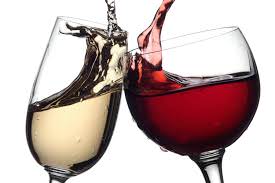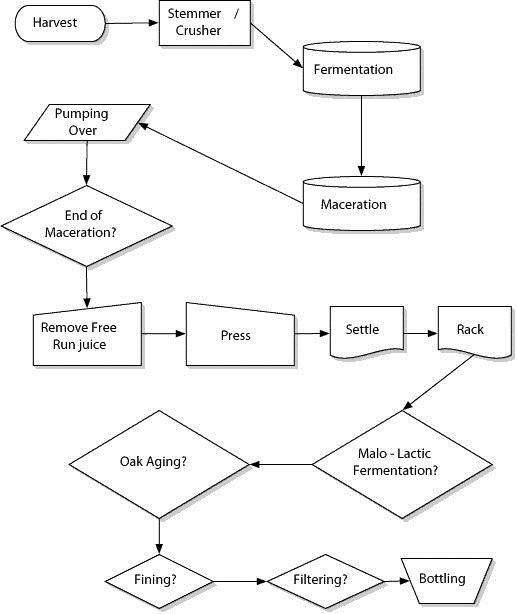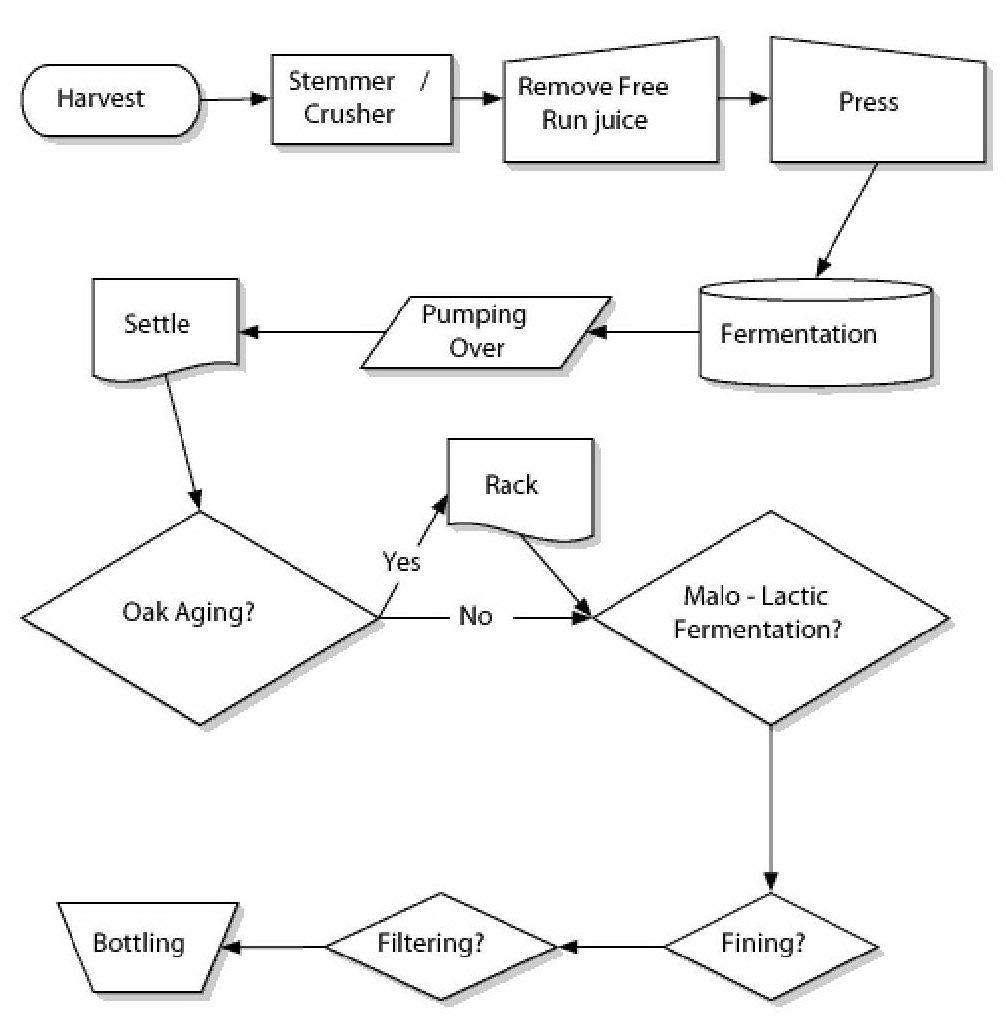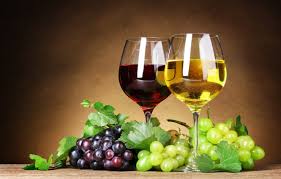Wine | Manufacturing | Classification and Brands
Wine is an alcoholic beverage produced by the natural fermentation of ripe, freshly gathered grapes – according to local traditions and practice.
Red Wine manufacturing -The Steps:
Harvest – The grapes are picked when they are ripe, usually as determined by taste and sugar readings.
Stemmer Crusher – This removes the stems from the grape bunches, and crushes the grapes (but does not press them) so that they are exposed to the yeast for fermenting, and so the skins can better impart color to the wines.
Fermentation – Yeast turn the sugar in the wine primarily into Carbon Dioxide, Heat and Alcohol.
Maceration – This is how long the must (juice and grape solids) is allowed to sit, picking up flavor, color and tannin. Too long and the wine is bitter, to short and it is thin.

Pumping Over – Skin and other solids float to the top, and need to be pushed back down to stay in contact with the must. This “cap” can be punched down with a tool, or you can pump must form the bottom over the cap and submerge it that way.
End of Maceration? – The winemaker must decide if the must has sat long enough.
Remove Free Run – The best quality wine is made just from the juice portion of the must. It is removed and the rest of the drier must (now called pomace) is sent to the press.
Press – This squeezes the remaining juice out of the pomace. If you do it too hard, or too many times, you get low quality wine.
Settle – The juice, now wine, needs to settle after this ordeal.
Rack(ing) – Moving the wine from one barrel to a new barrel allows you to leave solids and anything thatmight cloud the wine, behind.

Malo-Lactic Fermentation – This secondary fermentation can turn the tart malic acid (of green apples) into the softer lactic acid (of milk). Many, but not all red wines go through this step.
Oak Aging – Oak is expensive, if the wine is not meant to age for years, the winery may put the wine in oak for only a short time, or not at all.
Fining – A process that helps to remove anything that may be making the wine cloudy.
Filtering – A process that removes any fining agents, or other undesirable elements in the wine.
Bottling – This is done carefully so that the wine does not come in contact with air. Finer wines may be stored for several years in bottles before they are released.
White Wine Manufacturing Flow chart:
Harvest – The grapes are picked when they are ripe, usually as determined by taste and sugar readings.
Stemmer Crusher – This removes the stems from the grape bunches, and crushes the grapes (but does not press them) so that they are exposed to the yeast for fermenting, and so the skins can better impart color to the wine.
Remove Free Run – The best quality wine is made just from the juice portion of the must. It is removed and the rest of the drier must (now called pomace) is sent to the press.
Press – This squeezes the remaining juice out of the pomace. If you do it too hard, or too many times, you get low quality wine.
Fermentation – Yeast turn the sugar in the wine primarily into Carbon Dioxide, Heat and Alcohol.
Pumping Over – Skin and other solids float to the top, and need to be pushed back down to stay in contact with the must. This “cap” can be punched down with a tool, or you can pump must form the bottom over the cap and submerge it that way.
Settle – The juice, now wine, needs to settle after this ordeal.
Oak Aging – Oak is expensive, if the wine is not meant to age for years, the winery may put the wine in oak for only a short time, or not at all.
Rack(ing) – Moving the wine from one barrel to a new barrel allows you to leave solids and anything that might cloud the wine, behind.
Malo-Lactic Fermentation – This secondary fermentation can turn the tart malic acid (of green apples) into the softer lactic acid (of milk). Some, but not all white wines go through this step.
Fining – A process that helps to remove anything that may be making the wine cloudy.
Filtering – A process that removes any fining agents, or other undesirable elements in the wine.
Bottling – This is done carefully so that the wine does not come in contact with air. Finer wines may be stored for several years in bottles before they are released.

Examples of Wine Grapes
White Grapes
Chardonnay, Chenin Blanc , Colombard, Folle Blanche, Gewürztraminer, Müller-Thurgau, Muscat, Palomino, Pinot Blanc, Riesling, Saint Emilion, Sauvignon Blanc, Sercial, Trebbiano, Viognier
Black Grapes
Cabernet Franc, Cabernet Sauvignon, Cinsault, Gamay, Grenache, Malbec, Merlot, Nebbiolo, Pinot Noir, Syrah, Zinfandel, Pinot Meuniere
Classification of wine types
STILL WINE
This is the largest category. The alcoholic strength may be between 9% and 15%,
by volume. The wines may be:
- Red: being fermented in contact with grape skins from which the wine gets its colour. Normally dry wines.
- White: usually produced from white grapes, but the grape juice (must) is usually fermented away from the skins. Normally dry to very sweet.
- Rose: made in three ways – from red grapes fermented on the skins for up to 48 hours; by mixing red and white wines together; or by pressing grapes so that some colour is extracted. It may be dry or semi-sweet. These are called blush wines in the USA when made wholly from red grapes.
SPARKLING WINES
- The most famous is Champagne. This is made by the methode champenoise (secondary fermentation in the bottle) in an area of north-eastern France.
- Effervescent wines made outside this area are called vins mousseux or sparkling wines and are made by either the methode champenoise (now to be called methode traditionelle), the Charmat method (tank fermented and sometimes termed the methode cuve close), the transfer method, or the carbonation method.
- They may vary from brut (very dry), sec (medium dry), demi-sec (medium sweet), to doux (sweet).
FORTIFIED WINES
Fortified wines such as Sherry, Port and Madeira have been strengthened by the addition of alcohol, usually a grape spirit.
These are now known within the EC as liqueur wines or vins de liqueur. Their alcoholic strength may be between 15% and 22%, by volume.
- Sherry (from Spain) 15-18% ; made from white grapes -fino (dry), amontillado (medium), oloroso (sweet);
- Port (from Portugal) 18-22% ; strong sweet; typically drunk as a dessert wine – ruby, tawny, vintage character, late bottled vintage, vintage
- Madeira 18% (famous dessert wine; made on the Portuguese island of Madeira) – Sercial (dry), Verdelho (medium), Bual (sweet), Malmsey (very sweet)
- Marsala 18% – a dark sweet wine from Marsala in Sicily
Aromatied wines:– These are flavoured and fortified. Typical example is Vermouth.
VERMOUTH TYPES
The four main types of vermouth are;
- Dry vermouth:often called French vermouth or simply French. It is made from dry white wine thaf is flavoured arid Fortified.
- Sweet vermouthJbianco: made from dry white wine, flavoured, fortified and • sweetened with sugar or mistelle,
- Rose vermouth: made in a similar Way to Bianco but it is less sweet and is ^ coloured with caramel.
- Red vermouth: often called Italian vermouth, Italian or more often It (as in Gin and it). It is made from white wine and is flavoured, sweetened and coloured with a generous addition of caramel.
THE WINES OF FRANCE
- Appellation Controllé (controlled naming) laws – the name of wines reveals quality – helps prevent fraud & gives authenticity.
- Production and labeling governed by INAO – Institut Nationale des Appellation d’Origine des vins et Eau-de-vis
- The ground rule for naming French wines are basically geographical – area, grape-variety, yield, viticulture, vinification, ageing, alcohol-content and a taste-test.
| Gradings | Meaning |
| AOC | Appellation d’Origine Controllée; Highest quality and most prestigious grading for French Wines but produces only 25% of all wines |
| VDQS | Vins Délimités de Qualité Supérieure; Taste-test is a must; 5% of all wines. |
| Vin de Pay | Literally means ‘Country Wines’ |
| Vin de Table | Fully blended. |
| Vin Ordinaire | Labeled by alcohol-content; Sometimes cheaper than even mineral water! |
Wine Producing Regions of France
| Regions | Popular Wines |
| BORDEAUX :- Probably the most prestigious wine-region. | Château Lafite-Rothschild – Pauillac (Red) |
| Château La Tour-Pomerol (Red) | |
| Château Pape-Clément (red) | |
| Château Olivier (white) | |
| Château Couhins (white) | |
| Château d’Arche (white) | |
| BURGUNDY | Chambertin- R |
| Le Corton (r) | |
| Les Gréves (r | |
| Charlemagne (w) | |
| Montrachet (w) | |
| Morgeot (w), | |
| Rully (both red & white) | |
| Montagny (white) | |
| CÔTES-DU-RHÔNE | |
| VAL DE LOIRE | Anjou (w & r – sparkling) |
| Muscadet (w – dry) | |
| Pouilly Fumé (w – dry) | |
| Vouvray ( w – still & sparkling) | |
| ALSACE | Alsac Riesling |
| Alsac pinot blanc | |
| JURA | Château Chalon |
| Arbois | |
| PROVENCE | Cassis |
| LANGUEDOC-ROUSSILLON | St. Chinion |
| SOUTHWEST | Montravel |
| SAVOIE | Crépy (w – dry) |
WINES OF ITALY
- Half the size of France but quantity is almost equal.
- 60% reds – probably second only to Bordeaux and Burgundy
- More like Burgundies – robust, full-bodied, deep red.
- Wine regions:- LOMBARDY, TUSCANY, VENETO, PIEDMONT, SICILY
- Production and labeling governed by DOC (Denominazione di Origine Controllata)
Popular wines:-
| White | Red | SPARKLING WINES |
| Est! Est!! Est!!! | Bardolino (hardy red) | Asti Spumante |
| Falerno | Barolo (R | Lacrima Christi |
| Capri | Boca (r) | Asti Spumante |
| Etna | Fara | |
| Lugana | Barbaresco | |
| Galestro | Soave |
WINES OF SPAIN
- The third largest wine-producing country in the world.
- Home of fortified wine of Sherry
- Wines labeled DO (Denominacione de Origen) are of guaranteed standard
POPULAR WINES:-
| RED | WHITE |
| Marques de Riscal Gran Reserva | La Cana Albarino |
| Torres Mas La Plana | Burgans Albarino |
| Vega Sicilia Unico | Poema White Blend |
| Dominio de Pingus | Protocolo Blanco |
| Clos Erasmus | Shaya Verdejo |
| Clos Mogado |
PORTUGAL
- Climate not quite conducive for viticulture.; Even then, great variety and sufficient quantity.
- 15% of the populace is involved in wine trade
- Best wines are labeled Designacio de Origen (DO).
- Home of PORT & MADEIRA
POPULAR WINES:–
| PORT WINES | SHERRY | RED | WHITE |
| Churchill’s Crusted Port | BLANDY | CAMPOLARGO | BIOMANZ |
| Quinta do Naval Black | LEACOCK | JULIA KEMPER | FILIPA PATO |
| Dow’s White Port | PERIQUITA | QUINTA DO NOVAL | QUINTA DA PELLADA |
| BARBEITO | CASCA WINES | AFROS |
WINES OF U.S.A:-
- The 5th largest wine-producing country.
- Rosé wines are referred to as blush
- Quality is also commendable.
- Wine production started after the arrival of the European settlers in the 17th century
| WHITE | RED | SPARKLING |
| Heron California Chardonay | SKN Nappa Valley Cabernet Sauvignon | NV Gruet Brut |
| Windmill Lodi Chardonay | Bears Nappa Valley Cabernet Sauvignon | Mirabella Brut |
| Pine & Post Washington Chardonay | Mark West California Pinot Noir | Sofia Blanc de Blanc |
| Morgan Sauvignon Blanc | Lange Twins California Merlot | |
| Geyeser Peak Sauvgnon Blanc | Kendall Jackson California Syrah |
INDIAN WINES :–
- Harvest normally takes place in September and is usually done by hand
- Indigenous table grape varieties:- Anabeshahi, Arkavati and Arkashyam
| Wines Producing Regions | ||
| Nasik | · Located in the state of Maharashtra. | |
| · Region include Pune,Nasik,Ahmed Nagar. | ||
| · Several top wineries are located here. | ||
| · Chateau Indage, Sula wines. | ||
| Sangali Region | · Also located in Maharashtra. | |
| · This region includes places like | ||
| -solapur,sangali,satara and latur. | ||
| Bangalore Region | Grover Vineyards, located in Nandi Hills (45 kilometer North of Bangalore City) | |
| Himachal Region | · It is upcoming state for the wine in India. | |
Some Famous Wine Makers
Indage à Narayangaon (Pune)
Grover Vineyards àBangalore
Sula à Maharashtra
Renaissance Wines à Nashik
ND Wines à Nashik
| Red Wine | WHITE WINEs | Rose wines | Sparkling wine |
| Syrah | Sailo Rio | Shiraz rose | Sula Brut |
| Galaxy | Et tu Brutus | Maderas rose | Sula Seco |
| Vallet Sailo | Mark Antony | Sula Blush Zinfandel | |
| Satori Merlot | Sauvignon Blanc | ||
| Cabernet Shiraz | Dia white | ||
| La Reserve | Madera white |




